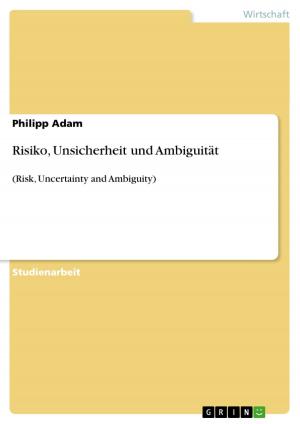Mergers. Value Creation or Destruction?
Synergies in Theory and Practice
Business & Finance, Finance & Investing, Finance| Author: | Matthias Runkel | ISBN: | 9783656851509 |
| Publisher: | GRIN Verlag | Publication: | December 1, 2014 |
| Imprint: | GRIN Verlag | Language: | English |
| Author: | Matthias Runkel |
| ISBN: | 9783656851509 |
| Publisher: | GRIN Verlag |
| Publication: | December 1, 2014 |
| Imprint: | GRIN Verlag |
| Language: | English |
Bachelor Thesis from the year 2011 in the subject Business economics - Investment and Finance, grade: 8,0 (out of 10), Maastricht University, language: English, abstract: Mergers and acquisition (M&A) are one of the most important topics in the business world. They provide so many news that online newspapers like the New York Times dedicate own sections to them. Some of the largest mergers did cost more than 100 billion US dollars. In consideration of this public interest and these enormous dollar amounts, a lot of research has been conducted to answer a fundamental question: Do mergers really create value? In order to answer this question, this paper gives an overview of influential research in the wide field of M&A. It is necessary to first provide a theoretical framework to show how a merger be-tween two firms creates synergies. In other words, how can the value of two merged companies be larger than their independent sum? With this framework in mind, it is possible to look at re-sults of academic research on whether mergers create value in practice and the determinants of success and failure. Another interesting topic in the field of M&A is merger waves, periods with abnormally high merger activity. Several of such waves have been observed, but their cause and return are still topic of academic debate. The remainder of this study is structured as follows. The next section reviews the most important reasons to merge in order to understand the theoretical value-creating potential. The third section discusses whether mergers also create value in practice and who benefits the most. Section four describes how merger success or failure depends on different properties of involved parties and deal characteristics. The fifth section gives a brief summary of the last three big merger waves and depicts how the occurrences of such waves are explained by two competing theories. The last section concludes the study.
Bachelor Thesis from the year 2011 in the subject Business economics - Investment and Finance, grade: 8,0 (out of 10), Maastricht University, language: English, abstract: Mergers and acquisition (M&A) are one of the most important topics in the business world. They provide so many news that online newspapers like the New York Times dedicate own sections to them. Some of the largest mergers did cost more than 100 billion US dollars. In consideration of this public interest and these enormous dollar amounts, a lot of research has been conducted to answer a fundamental question: Do mergers really create value? In order to answer this question, this paper gives an overview of influential research in the wide field of M&A. It is necessary to first provide a theoretical framework to show how a merger be-tween two firms creates synergies. In other words, how can the value of two merged companies be larger than their independent sum? With this framework in mind, it is possible to look at re-sults of academic research on whether mergers create value in practice and the determinants of success and failure. Another interesting topic in the field of M&A is merger waves, periods with abnormally high merger activity. Several of such waves have been observed, but their cause and return are still topic of academic debate. The remainder of this study is structured as follows. The next section reviews the most important reasons to merge in order to understand the theoretical value-creating potential. The third section discusses whether mergers also create value in practice and who benefits the most. Section four describes how merger success or failure depends on different properties of involved parties and deal characteristics. The fifth section gives a brief summary of the last three big merger waves and depicts how the occurrences of such waves are explained by two competing theories. The last section concludes the study.















